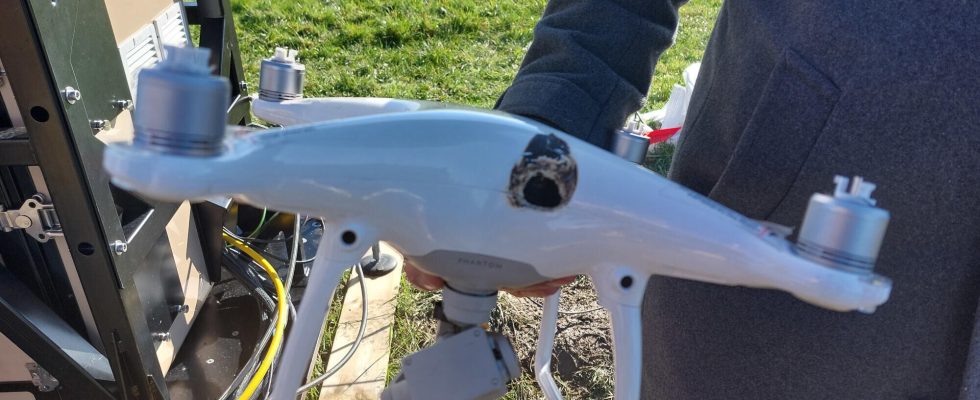Only 126 days left until the opening ceremony of the Olympic Games on the Seine in Paris. Security will be maximum for the event with 45,000 police and gendarmes mobilized. The French government also anticipates threats from the sky, particularly drones. The Air Force has been preparing and carrying out several exercises in recent weeks to anticipate this risk.
5 mins
Drones are “ undoubtedly the main threat to be apprehended “, exposed French Interior Minister Gérald Darmanin, on May 23 when the security protocol for the opening ceremony of the Paris Olympic Games was signed. The French authorities fear a scenario: that of a civilian “kamikaze” drone equipped with an explosive charge, targeting the crowd.
Until now, no attack of this type has taken place in France on national soil. This has already happened, however, on military grounds abroad. In 2016, in Erbil, Iraq, a booby-trapped drone injured two members of the French special forces and killed two Kurdish peshmerga. The attack was likely carried out by the Islamic State group.
More and more drones in circulation
The risk therefore exists, in particular because the number of drones in circulation in France has greatly increased in recent years. In 2017, there were 400,000 in circulation and 2.5 million in 2021, according to a Senate report. The drone is therefore a very accessible object. “It is this ease of obtaining the means, anywhere on the territory which makes this drone threat very activeexplains Thibault Fouillet, scientific director of the Institute for Strategy and Defense Studies. Especially since we cannot easily identify the acquisition channels, the assembly and implementation sectors “, explains the researcher.
In fact, the first models of drones can be bought for around a hundred euros in stores, which helps to make them a threat and a weapon. low cost » for a terrorist group.
To counter this risk, the Air Force is therefore preparing. She has been training for several weeks at Villacoublay air base 107, near Paris, where several devices are tested. This is the case of detection radars capable of spotting a drone and sending the information to software developed by the army and called “Shared Air Situation” (SAP).
This software is a visualization tool that makes it possible to interpret the information transmitted by the radar, explains Lieutenant-Colonel Thomas: “ We have a database that contains all drones accredited and authorized to fly in the area. When a drone appears on the screen, SAP will compare it with this database and if it is not associated with a flight plan or accreditation, it will suggest to the operator to treat it as a drone who has nothing to do there. »
Detection, neutralization, interception
This detection work is essential, because it makes it possible to avoid targeting drones authorized to fly within the security perimeter, such as television drones responsible for filming the opening ceremony of the Olympic Games. But what will happen if a drone authorized to fly no longer respects the flight plan? “ It could have been hacked or the pilot could be forced to act under duressimagines General Arnaud Bourguignon, responsible for air protection of the Olympic Games. In this case, we will not take any risks, we will treat it like a drone which has nothing to do there. »
After the detection of the aircraft, comes the stage of its neutralization. To do this, the army has laser rifles which burn out the drone’s electronic systems and jamming rifles. “ A drone arrives towards us, the gendarme aims his jamming rifle towards the aircraft and the drone is stopped dead », Explains General Arnaud Bourguignon, supporting demonstration. The connection is therefore cut with the drone pilot, but the machine remains in hover.
To intercept it, the Air Force has two options. First, the use of net-launching rifles with a range of 100 meters. The net has a wingspan of almost 3 meters and is equipped with a parachute, so that the drone, once captured, does not fall on the public.
It is difficult to know precisely the effectiveness of all these devices which constitute the “Parade” anti-drone combat system developed by the Air Force. A year ago, “ malfunctions » and delivery delays were noted with concern by Les Républicains senator Cédric Perrin, also chairman of the Senate Foreign Affairs, Defense and Armed Forces Committee.
A year later, everything is in place, assures the Air Force which insists: it is the combination of all the anti-drone fight devices which will make it possible to create a real “protective dome” of the Olympic sites. There will be around fifteen to protect.
An overestimated threat?
The threat of drones therefore exists, but be careful not to overestimate it, believes Thibault Fouillet: “ I am a little more moderate than Gérald Darmanin [quand il parle de « principale menace à appréhender]. I even think that there is a real danger in focusing on a single threat. It minimizes all the others by making people believe that they no longer exist or that they are under control. However, the problem with terrorism is precisely that it is a global threat. »
The researcher sees it above all as a political discourse: “ There is a need for public discourse and in particular for the government to address this issue to show its determination and prove that they have done their utmost. It is also a way of protecting yourself. Even if the threat materialized, they would be spared any criticism of the lack of anticipation. »
On the side of the Air Force, we recall the need, to anticipate the threat, to deal with it as early as possible. By also maximizing efforts on intelligence.
Also listenLines of defense – The difficult parade against the threat of drones
